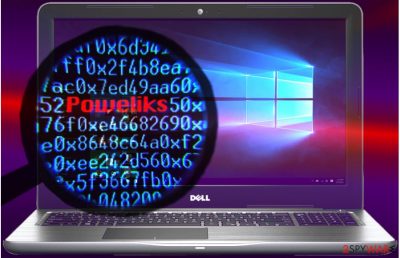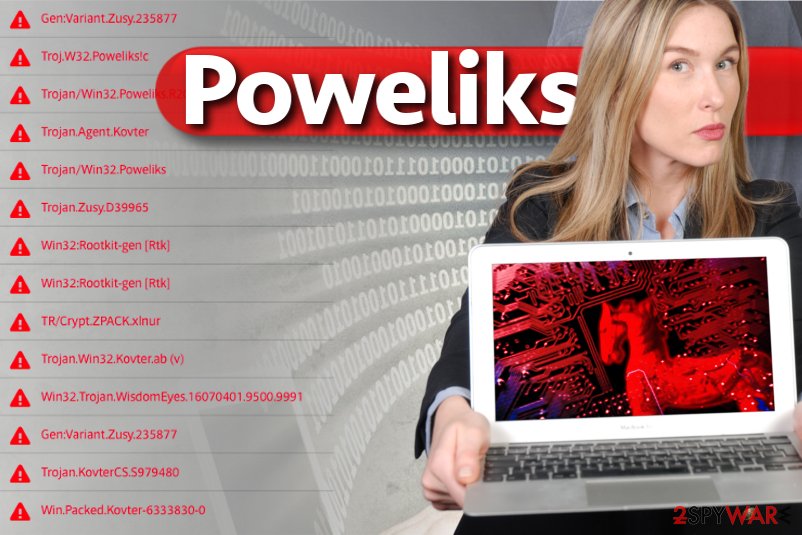Poweliks virus (Removal Instructions) - Sep 2017 update
Poweliks virus Removal Guide
What is Poweliks virus?
Poweliks virus is a fileless infection that is hard to remove

Powerliks virus (also known as Trojan.Poweliks, Trojan.Poweliks!gm, etc.) is a dangerous trojan horse[1]. Unlike regular viruses, it does not create a physical file on the operating system in order to operate. Instead, it injects a malicious code into a legitimate Windows process that is already running on the system and avoids detection this way.
At the moment of writing, it is capable of affecting only those machines that use Windows OS. Nevertheless, viruses are updated each day, so there is no guarantee that this threat won't start infecting other machines in a very near future. Just like with any other trojan horse, we highly recommend avoiding such threats as Trojan.Powerliks because they can be used for a long list of malicious activities.
In most of the cases, Powerliks virus can be used for infecting your PC system with related malware. In addition, it can also launch it, download its updates and initiate other dangerous activities that can be received from a remote attacker.
Usually, the Powerliks Trojan performs click-fraud operations. It repeatedly connects to various domains and loads advertisements from them. The malicious virus interacts with these advertisements without user's knowledge and this way earns money for its developers by using victim's computer's power and Internet connection.
The most obvious sign showing that Poweliks is already hiding in your PC system is the appearance of DLLHOST.exe, dllhst3g.exe, dllhost.exe *32, dllhst3g.exe *32 and similar entries in your Task Manager.
You probably already noticed that the malicious virus tends to obfuscate its presence by infecting legitimate processes and making them run malicious tasks. This helps the malware avoid detection and, obviously, instant removal even if the user is running a security software. However, DieViren.de experts say[2] that if you are using an anti-malware software that is up-to-date, you should not have any problems with Poweliks removal.
In addition, you can notice that your PC is slower than it used to be, programs are taking more time when you are trying to launch them, some part of legitimate websites are unreachable, etc. If these issues are already bothering you, you should run a full system scan with FortectIntego or other reputable anti-spyware and remove Poweliks virus immediately.

Ways to infiltrate target system
According to various security experts, this threat is mostly spread using Trojan.Mdropper. This trojan can be downloaded from illegal websites that are typically used for spreading various viruses. Also, this cyber infection can easily try to infect your PC via spam, misleading notifications and similar ways of distribution, so we highly recommend avoiding mails that report about unexpected prizes and winnings.
In addition, you should also stay away from ads offering you to update your Flash Player, FLV Player and similar programs. For that you should use only official websites of programs. Finally, in order to stay safe, you should always keep your PC protected as it should be.
This means that you should make sure that you have not only anti-virus installed on your machine. You should also install a reputable anti-spyware and try to keep it up-to-date. This will help you to avoid security vulnerabilities and will also prevent infiltration of such threats like this one.
Remove Powerliks virus and clean up the mess it made in your computer system
The Trojan is still active today, so if you want to remove Poweliks 2017 virus, consider installing an up-to-date anti-malware software. If you want to make sure that your PC is safe, you should run a full system scan with one of these programs: FortectIntego, SpyHunter 5Combo Cleaner, Malwarebytes. Make sure you use updated versions in order to remove all suspicious files form your computer.
We do not advise you to try to perform Poweliks removal manually as this requires specific computing skills. The described Trojan is considered to be a fileless infection[3] which means that it is not enough to delete some files from the system to get rid of it. To completely fix the damage done by the malicious software, use automatic malware removal programs.
Getting rid of Poweliks virus. Follow these steps
Manual removal using Safe Mode
To successfully remove Poweliks, use the provided directions to restart your computer into a right mode for malware removal.
Important! →
Manual removal guide might be too complicated for regular computer users. It requires advanced IT knowledge to be performed correctly (if vital system files are removed or damaged, it might result in full Windows compromise), and it also might take hours to complete. Therefore, we highly advise using the automatic method provided above instead.
Step 1. Access Safe Mode with Networking
Manual malware removal should be best performed in the Safe Mode environment.
Windows 7 / Vista / XP
- Click Start > Shutdown > Restart > OK.
- When your computer becomes active, start pressing F8 button (if that does not work, try F2, F12, Del, etc. – it all depends on your motherboard model) multiple times until you see the Advanced Boot Options window.
- Select Safe Mode with Networking from the list.

Windows 10 / Windows 8
- Right-click on Start button and select Settings.

- Scroll down to pick Update & Security.

- On the left side of the window, pick Recovery.
- Now scroll down to find Advanced Startup section.
- Click Restart now.

- Select Troubleshoot.

- Go to Advanced options.

- Select Startup Settings.

- Press Restart.
- Now press 5 or click 5) Enable Safe Mode with Networking.

Step 2. Shut down suspicious processes
Windows Task Manager is a useful tool that shows all the processes running in the background. If malware is running a process, you need to shut it down:
- Press Ctrl + Shift + Esc on your keyboard to open Windows Task Manager.
- Click on More details.

- Scroll down to Background processes section, and look for anything suspicious.
- Right-click and select Open file location.

- Go back to the process, right-click and pick End Task.

- Delete the contents of the malicious folder.
Step 3. Check program Startup
- Press Ctrl + Shift + Esc on your keyboard to open Windows Task Manager.
- Go to Startup tab.
- Right-click on the suspicious program and pick Disable.

Step 4. Delete virus files
Malware-related files can be found in various places within your computer. Here are instructions that could help you find them:
- Type in Disk Cleanup in Windows search and press Enter.

- Select the drive you want to clean (C: is your main drive by default and is likely to be the one that has malicious files in).
- Scroll through the Files to delete list and select the following:
Temporary Internet Files
Downloads
Recycle Bin
Temporary files - Pick Clean up system files.

- You can also look for other malicious files hidden in the following folders (type these entries in Windows Search and press Enter):
%AppData%
%LocalAppData%
%ProgramData%
%WinDir%
After you are finished, reboot the PC in normal mode.
Remove Poweliks using System Restore
-
Step 1: Reboot your computer to Safe Mode with Command Prompt
Windows 7 / Vista / XP- Click Start → Shutdown → Restart → OK.
- When your computer becomes active, start pressing F8 multiple times until you see the Advanced Boot Options window.
-
Select Command Prompt from the list

Windows 10 / Windows 8- Press the Power button at the Windows login screen. Now press and hold Shift, which is on your keyboard, and click Restart..
- Now select Troubleshoot → Advanced options → Startup Settings and finally press Restart.
-
Once your computer becomes active, select Enable Safe Mode with Command Prompt in Startup Settings window.

-
Step 2: Restore your system files and settings
-
Once the Command Prompt window shows up, enter cd restore and click Enter.

-
Now type rstrui.exe and press Enter again..

-
When a new window shows up, click Next and select your restore point that is prior the infiltration of Poweliks. After doing that, click Next.


-
Now click Yes to start system restore.

-
Once the Command Prompt window shows up, enter cd restore and click Enter.
Finally, you should always think about the protection of crypto-ransomwares. In order to protect your computer from Poweliks and other ransomwares, use a reputable anti-spyware, such as FortectIntego, SpyHunter 5Combo Cleaner or Malwarebytes
How to prevent from getting trojans
Stream videos without limitations, no matter where you are
There are multiple parties that could find out almost anything about you by checking your online activity. While this is highly unlikely, advertisers and tech companies are constantly tracking you online. The first step to privacy should be a secure browser that focuses on tracker reduction to a minimum.
Even if you employ a secure browser, you will not be able to access websites that are restricted due to local government laws or other reasons. In other words, you may not be able to stream Disney+ or US-based Netflix in some countries. To bypass these restrictions, you can employ a powerful Private Internet Access VPN, which provides dedicated servers for torrenting and streaming, not slowing you down in the process.
Data backups are important – recover your lost files
Ransomware is one of the biggest threats to personal data. Once it is executed on a machine, it launches a sophisticated encryption algorithm that locks all your files, although it does not destroy them. The most common misconception is that anti-malware software can return files to their previous states. This is not true, however, and data remains locked after the malicious payload is deleted.
While regular data backups are the only secure method to recover your files after a ransomware attack, tools such as Data Recovery Pro can also be effective and restore at least some of your lost data.
- ^ Charlie Osborne. Poweliks Trojan goes fileless to evade detection and removal. ZDNet. Technology News, Analysis, Comments and Product Reviews.
- ^ DieViren. DieViren. Security and Spyware News.
- ^ Lily Hay Newman. Say Hello to the Super-Stealthy Malware That’s Going Mainstream. WIRED. Business, Technology, Lifestyle News.





















